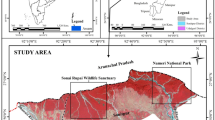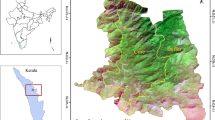Abstract
India is a biodiversity-rich country. The panorama of Indian forests ranges from tropical evergreen rain forests in the Andaman and Nicobar Islands, the Western Ghats, and the north-eastern States, to Dry Alpine Scrub high in the Himalayas in the north. On the other extreme, tropical dry deciduous and thorn forest is found in the deserts and dry areas of Rajasthan and Gujarat. The variety and distribution of forest vegetation are large, and India is one of the 17 mega biodiversity regions of the world. Forestry in India supports a sizeable non-wood forest product-based economy apart from timber and fuelwood. In forested landscapes people are integrated with forest and make living out of it. On the other hand urbanization and infrastructure development are putting considerable pressure on forests. These issues need effective and efficient forest monitoring system. Hence in late 1980s, India entrusted Forest Survey of India to evolve robust and scientific method of forest monitoring. Thus, India has taken an early lead in establishing a forest monitoring system. The history of forest cover mapping using satellite images in the country goes back to 1983 when National Remote Sensing Agency (NRSA—now known as NRSC-ISRO) prepared the first-ever forest cover map of India. Later, Forest Survey of India has been mandated with the forest cover mapping of the country in the biennial cycle since 1987. Three decades of forest cover mapping on a regular basis have been a remarkable achievement in the field of natural resource monitoring. India’s remote sensing-based periodic monitoring of forest cover, which is unique in the world, has played a major role in conservation and enhancement of forest cover of the country. Evolving with satellite data improvement and technological advancements, the methodology of forest cover mapping by FSI has seen significant changes over the years, wherein Indian remote sensing data, particularly the IRS 1C/1D LISS III data, have been the primary input in the time series mapping. This paper reviews the chronology and significance of this important forest monitoring programme of India.
Similar content being viewed by others
References
Achard, F., DeFries, R., Eva, H., Hansen, M., Mayaux, P., & Stibig, H. (2007). Pan-tropical monitoring of deforestation. Environmental Research Letters, 2(4), 2–6.
Busch, J., Kapur, A., & Mukherjee, A. (2019). Ecological fiscal transfers and subnational budgets: Did forest-based fiscal devolution lead Indian states to increase forestry expenditure? CGD Policy Paper, 159, 1–3.
FSI. (2019). India State of Forest Report 2019. Forest Survey of India. https://www.fsi.nic.in/forest-report-2019.
Joshi, A., Pant, P., Kumar, P., Giriraj, A., & Joshi, P. K. (2010). National forest policy in india: critique of targets and implementation. Small-Scale Forestry, 10, 83–96.
Kleinn, C. (2000). Estimating metrics of forest spatial pattern from large area forest inventory cluster samples. Forest Science, 46(4), 548–557.
MoEF&CC. (2014). Revision of rates of NPV applicable for different class/category of forests. Nov 2014, pp. 14–28.
National Remote Sensing Agency. (1983). Nationwide mapping of forest and non-forest areas using landsat false colour composite for the periods 1972–1975 and 1980–1982. Project Report, 1 & 2, 1–34.
Norman, M., & Nakhooda, S. (2015). The state of REDD + finance. Working paper #378. Center for Global Development, Washington, DC, May 2015 (pp. 3–11).
Reddy, C. S., Jha, C. S., Dadhwal, V. K., Harikrishna, P., Pasha, S. V., Satish, K. V., et al. (2016). Quantification and monitoring of deforestation in India over eight decades (1930–2013). Biodiversity and Conservation, 25(1), 93–116.
Romijn, E., Lantican, C. B., Herold, M., Lindquist, E., Ochieng, R., Wijaya, A., et al. (2015). Assessing change in national forest monitoring capacities of 99 tropical countries. Forest Ecology and Management, 352, 109–123.
Rosencranz, A., & Lele, S. (2008). Supreme court and India’s forests. Economic & Political Weekly, 43(5), 11–14.
Roy, P. S., Behera, M. D., Murthy, M. S. R., Roy, A., Singh, S., Kushwaha, S. P. S., et al. (2015). New vegetation type map of India prepared using satellite remote sensing: Comparison with global vegetation maps and utilities. International Journal of Applied Earth Observation and Geoinformation, 39, 142–159.
Roy, P. S., Kushwaha, S. P. S., Murthy, M. S. R., Roy, A., Kushwaha, D., Reddy, C. S., et al. (2012). Biodiversity characterization at landscape level: National assessment (pp. 1–254). Dehra Dun: Indian Institute of Remote Sensing.
UNFCCC. (2018). India’s proposed submission on forest reference levels for REDD + result based payments under UNFCCC. Retrieved September, 10, 2020, from https://redd.unfccc.int/files/2018_frel_submission_india.pdf.
Weitao, Z., Weipeng, J., Guangsheng, C., Yang, L., & Houbing, S. (2019). A survey of big data analytics for smart forestry. IEEE Access, 7, 46621–46636.
Author information
Authors and Affiliations
Corresponding author
Additional information
Publisher's Note
Springer Nature remains neutral with regard to jurisdictional claims in published maps and institutional affiliations.
About this article
Cite this article
Ashutosh, S., Roy, P.S. Three Decades of Nationwide Forest Cover Mapping Using Indian Remote Sensing Satellite Data: A Success Story of Monitoring Forests for Conservation in India. J Indian Soc Remote Sens 49, 61–70 (2021). https://doi.org/10.1007/s12524-020-01279-1
Received:
Accepted:
Published:
Issue Date:
DOI: https://doi.org/10.1007/s12524-020-01279-1







